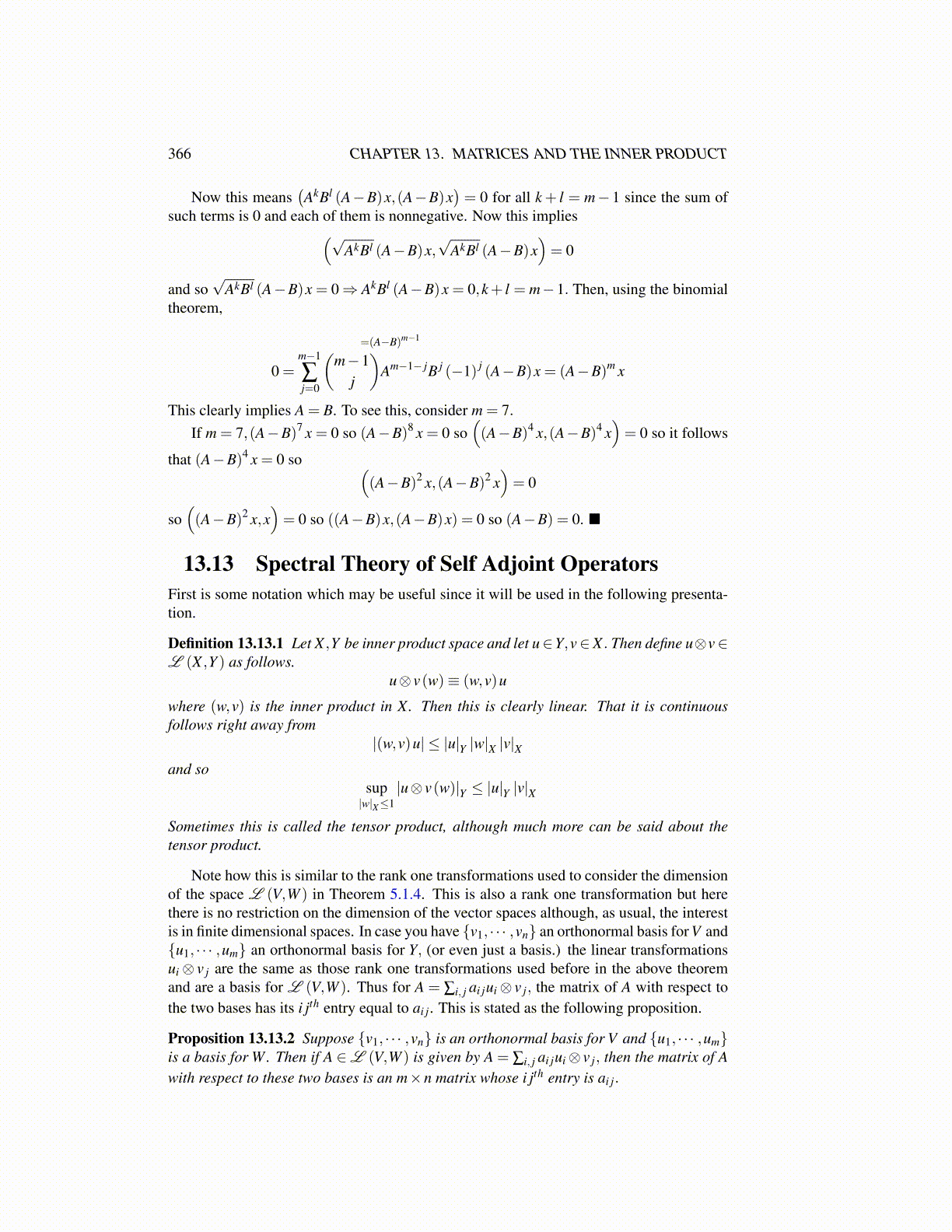
366 CHAPTER 13. MATRICES AND THE INNER PRODUCT
Now this means(AkBl (A−B)x,(A−B)x
)= 0 for all k+ l = m− 1 since the sum of
such terms is 0 and each of them is nonnegative. Now this implies(√AkBl (A−B)x,
√AkBl (A−B)x
)= 0
and so√
AkBl (A−B)x = 0⇒ AkBl (A−B)x = 0,k+ l = m−1. Then, using the binomialtheorem,
0 =
=(A−B)m−1
m−1
∑j=0
(m−1
j
)Am−1− jB j (−1) j (A−B)x = (A−B)m x
This clearly implies A = B. To see this, consider m = 7.If m = 7,(A−B)7 x = 0 so (A−B)8 x = 0 so
((A−B)4 x,(A−B)4 x
)= 0 so it follows
that (A−B)4 x = 0 so ((A−B)2 x,(A−B)2 x
)= 0
so((A−B)2 x,x
)= 0 so ((A−B)x,(A−B)x) = 0 so (A−B) = 0. ■
13.13 Spectral Theory of Self Adjoint OperatorsFirst is some notation which may be useful since it will be used in the following presenta-tion.
Definition 13.13.1 Let X ,Y be inner product space and let u∈Y,v∈X . Then define u⊗v∈L (X ,Y ) as follows.
u⊗ v(w)≡ (w,v)u
where (w,v) is the inner product in X. Then this is clearly linear. That it is continuousfollows right away from
|(w,v)u| ≤ |u|Y |w|X |v|Xand so
sup|w|X≤1
|u⊗ v(w)|Y ≤ |u|Y |v|X
Sometimes this is called the tensor product, although much more can be said about thetensor product.
Note how this is similar to the rank one transformations used to consider the dimensionof the space L (V,W ) in Theorem 5.1.4. This is also a rank one transformation but herethere is no restriction on the dimension of the vector spaces although, as usual, the interestis in finite dimensional spaces. In case you have {v1, · · · ,vn} an orthonormal basis for V and{u1, · · · ,um} an orthonormal basis for Y, (or even just a basis.) the linear transformationsui⊗ v j are the same as those rank one transformations used before in the above theoremand are a basis for L (V,W ). Thus for A = ∑i, j ai jui⊗ v j, the matrix of A with respect tothe two bases has its i jth entry equal to ai j. This is stated as the following proposition.
Proposition 13.13.2 Suppose {v1, · · · ,vn} is an orthonormal basis for V and {u1, · · · ,um}is a basis for W. Then if A ∈L (V,W ) is given by A = ∑i, j ai jui⊗ v j, then the matrix of Awith respect to these two bases is an m×n matrix whose i jth entry is ai j.